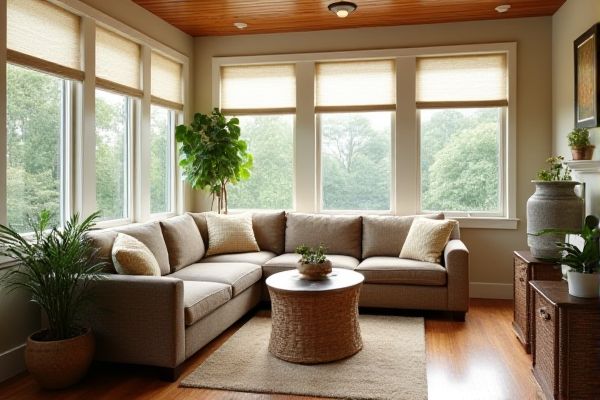
Sunroom window tint reduces heat and glare while enhancing privacy without obstructing your view, offering a sleek, low-maintenance solution compared to blinds that require regular cleaning and can block natural light when closed. Explore the rest of the article to discover which option best suits your sunroom needs and lifestyle.
Table of Comparison
| Feature | Sunroom Window Tint | Blinds |
|---|---|---|
| Light Control | Reduces glare while allowing natural light | Blocks or filters light completely or partially |
| Heat Reduction | Blocks up to 99% UV rays and reduces heat | Provides insulation but less effective at heat blocking |
| Privacy | Offers daytime privacy with tinted film | Full privacy when closed |
| Maintenance | Low maintenance; easy to clean with mild solutions | Requires regular dusting and occasional repairs |
| Aesthetic Impact | Sleek, modern look enhancing window appearance | Varied styles and colors; can impact room decor |
| Installation | Professional installation recommended | DIY possible; professional installation optional |
| Cost | Moderate initial cost; long-term energy savings | Varies widely; generally lower initial cost |
| Durability | Long-lasting, fade-resistant films | Can wear out or warp over time |
Introduction to Sunroom Window Treatments
Sunroom window tint reduces glare and UV rays while maintaining natural light, enhancing energy efficiency and protecting your furniture. Blinds offer adjustable privacy and light control, allowing you to customize the ambiance throughout the day. Your choice depends on whether you prioritize uninterrupted outdoor views or flexible shading options.
What Is Sunroom Window Tint?
Sunroom window tint is a specialized film applied directly to glass surfaces to reduce heat, glare, and UV radiation while preserving natural light. Unlike blinds, which physically block views and can interrupt room aesthetics, window tint maintains a clear exterior appearance and offers continuous protection without bulk. High-performance tints enhance energy efficiency by minimizing solar heat gain, contributing to a more comfortable sunroom environment year-round.
What Are Blinds for Sunrooms?
Blinds for sunrooms are window treatments designed to control sunlight, reduce glare, and enhance privacy while maintaining the room's bright and airy atmosphere. These blinds come in various materials such as aluminum, fabric, or wood, offering adjustable slats or shades to regulate light and temperature effectively. Unlike sunroom window tint, which is a permanent film applied directly to the glass, blinds provide flexible control and can be easily opened or closed to suit different lighting needs.
Energy Efficiency: Tint vs. Blinds
Sunroom window tint improves energy efficiency by reducing solar heat gain, lowering cooling costs while maintaining natural light. Blinds provide adjustable shading but often trap heat between the glass and fabric, reducing their effectiveness compared to tinting. Your energy savings are maximized with window tint, which offers consistent heat reduction without sacrificing brightness.
Privacy Comparison: Window Tint vs. Blinds
Sunroom window tint offers consistent privacy by reducing visibility from outside without obstructing natural light, making it ideal for maintaining an open, bright space. Blinds provide adjustable privacy levels, allowing users to control light and visibility but can block sunlight completely when closed. While window tint ensures all-day privacy with minimal maintenance, blinds offer flexibility but require manual adjustment and regular upkeep.
UV Protection and Sun Damage Prevention
Sunroom window tint offers superior UV protection by blocking up to 99% of harmful ultraviolet rays, effectively preventing sun damage to your furniture, flooring, and skin. Unlike blinds, which can only cover windows partially and allow UV rays to enter through gaps, window tint provides continuous coverage without obstructing your view or natural light. Your choice of tint enhances energy efficiency while preserving the aesthetic appeal and comfort of your sunroom.
Aesthetics and Design Flexibility
Sunroom window tint offers sleek, unobtrusive aesthetics by maintaining clear views and allowing natural light while reducing glare and heat, enhancing your sunroom's ambiance without adding bulky fixtures. Blinds provide versatile design options through various materials, patterns, and colors, enabling precise control over privacy and light but may disrupt the open, airy feel of the space. Choosing between tint and blinds depends on your preference for minimalist, uninterrupted views or customizable, tactile window treatments.
Installation and Maintenance Differences
Sunroom window tint involves applying a film directly to the glass, providing a seamless installation that requires professional tools but minimal ongoing upkeep beyond occasional cleaning. Blinds require mounting hardware and more complex installation steps, often necessitating precise measurements and drilling, with maintenance involving regular dusting and potential repairs to moving parts. While tint offers a sleek, low-maintenance solution that reduces glare and UV rays, blinds provide adjustable light control but demand more frequent attention to keep them functioning and looking clean.
Cost Analysis: Tint vs. Blinds
Sunroom window tinting offers a cost-effective solution with lower upfront expenses and minimal maintenance compared to blinds, which often require periodic replacement and cleaning. Tinting provides long-term energy savings by reducing heat gain and UV exposure, whereas blinds can incur higher energy costs if left open during peak sunlight. Your choice between sunroom window tint and blinds should consider installation costs, durability, and ongoing energy efficiency benefits.
Choosing the Best Option for Your Sunroom
Sunroom window tint offers superior heat reduction and UV protection while maintaining a clear view of the outdoors, making it an energy-efficient choice for enhancing comfort. Blinds provide versatile light control and privacy, allowing you to adjust brightness and ambiance according to your needs. When choosing the best option for your sunroom, consider factors such as desired visibility, energy savings, and ease of use to ensure optimal functionality and enjoyment.
 homyna.com
homyna.com